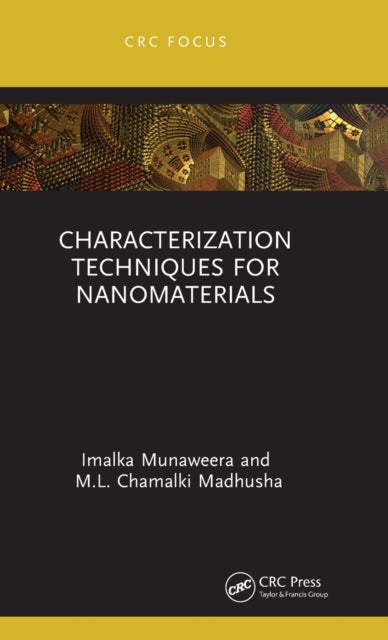M.L. ChamalkiMadhusha,ImalkaMunaweera
Characterization Techniques for Nanomaterials
Characterization Techniques for Nanomaterials
YOU SAVE £2.50
- Condition: Brand new
- UK Delivery times: Usually arrives within 2 - 3 working days
- UK Shipping: Fee starts at £2.39. Subject to product weight & dimension
Bulk ordering. Want 15 or more copies? Get a personalised quote and bigger discounts. Learn more about bulk orders.
Couldn't load pickup availability
- More about Characterization Techniques for Nanomaterials
This book provides a comprehensive understanding of physical and chemical characterization techniques of nanomaterials, covering basic principles, instrumentation, and examples of analysis. It discusses chemical and structural characterization techniques, including X-ray diffraction, Raman spectroscopy, and transmission electron microscopy, to obtain accurate and precise details of nanomaterials' structural and chemical properties.
Format: Hardback
Length: 98 pages
Publication date: 01 March 2023
Publisher: Taylor & Francis Ltd
Nanomaterials are a fascinating and rapidly evolving field of research, with a wide range of applications in various industries. Characterization is an essential step in understanding the physical and chemical properties of nanomaterials, which can help researchers and scientists develop new materials and technologies. In this article, we will explore the various physical and chemical characterization techniques of nanomaterials, including basic principles, instrumentation, and examples of analysis.
Physical characterization techniques:
Scanning Electron Microscopy (SEM): SEM is a powerful tool for imaging and analyzing nanomaterials at the microscale. It uses a beam of electrons to scan the surface of a material and generate high-resolution images of its structure. SEM can be used to identify the size, shape, and morphology of nanomaterials, as well as their elemental composition.
Transmission Electron Microscopy (TEM): TEM is similar to SEM, but it uses a beam of electrons with a higher energy to generate images of nanomaterials at the nanoscale. TEM can be used to study the internal structure of nanomaterials, including their crystalline structure, phase transitions, and defects.
X-ray Diffraction (XRD): XRD is a technique used to analyze the crystalline structure of materials. It uses X-rays to diffract the crystalline planes of a material and generate a pattern of diffraction peaks. XRD can be used to identify the crystal structure of nanomaterials, as well as their phase transitions and defects.
Raman Spectroscopy: Raman spectroscopy is a technique used to analyze the vibrational properties of materials. It uses a laser to excite the vibrational modes of a material and generate a spectrum of Raman peaks. Raman spectroscopy can be used to identify the chemical composition of nanomaterials, as well as their structural and chemical properties.
Nanoparticle Tracking Analysis (NTA): NTA is a technique used to measure the size and size distribution of nanoparticles in a solution. It uses a laser to track the movement of nanoparticles in a solution and generate a histogram of particle sizes. NTA can be used to study the behavior of nanoparticles in solution, as well as their interactions with other materials.
Chemical characterization techniques:
X-ray Photoelectron Spectroscopy (XPS): XPS is a technique used to analyze the elemental composition of materials at the surface level. It uses X-rays to photoelectron the surface of a material and generate a spectrum of XPS peaks. XPS can be used to identify the elemental composition of nanomaterials, as well as their chemical state and bonding configuration.
Thermal Analysis: Thermal analysis is a technique used to study the thermal properties of materials. It includes techniques such as differential scanning calorimetry (DSC), thermogravimetric analysis (TGA), and thermal gravimetric analysis (TGA). Thermal analysis can be used to identify the phase transitions, melting points, and thermal stability of nanomaterials.
Atomic Force Microscopy (AFM): AFM is a technique used to study the surface topography and mechanical properties of materials at the nanoscale. It uses a cantilever tip to probe the surface of a material and generate high-resolution images of its structure. AFM can be used to study the surface roughness, adhesion, and friction of nanomaterials.
Electron Spin Resonance (ESR): ESR is a technique used to study the magnetic properties of materials. It uses a magnetic field to excite the electrons of a material and generate a spectrum of ESR peaks. ESR can be used to study the magnetic properties of nanomaterials, as well as their spin-related properties.
Nanomaterial characterization is an important step in understanding the structural and chemical properties of nanomaterials, which can help researchers and scientists develop new materials and technologies. The physical characterization techniques discussed above, such as SEM, TEM, XRD, Raman spectroscopy, and NTA, can provide detailed information about the size, shape, and morphology of nanomaterials. The chemical characterization techniques, such as XPS, thermal analysis, AFM, and ESR, can provide information about the elemental composition, chemical state, and magnetic properties of nanomaterials.
In conclusion, nanomaterial characterization is a crucial step in understanding the physical and chemical properties of nanomaterials. By using a combination of physical and chemical characterization techniques, researchers and scientists can obtain accurate and precise details of the structural and chemical properties of nanomaterials, which can help them develop new materials and technologies.
Weight: 244g
Dimension: 223 x 142 x 13 (mm)
ISBN-13: 9781032406619
This item can be found in:
UK and International shipping information
UK and International shipping information
UK Delivery and returns information:
- Delivery within 2 - 3 days when ordering in the UK.
- Shipping fee for UK customers from £2.39. Fully tracked shipping service available.
- Returns policy: Return within 30 days of receipt for full refund.
International deliveries:
Shulph Ink now ships to Australia, Belgium, Canada, France, Germany, Ireland, Italy, India, Luxembourg Saudi Arabia, Singapore, Spain, Netherlands, New Zealand, United Arab Emirates, United States of America.
- Delivery times: within 5 - 10 days for international orders.
- Shipping fee: charges vary for overseas orders. Only tracked services are available for most international orders. Some countries have untracked shipping options.
- Customs charges: If ordering to addresses outside the United Kingdom, you may or may not incur additional customs and duties fees during local delivery.


